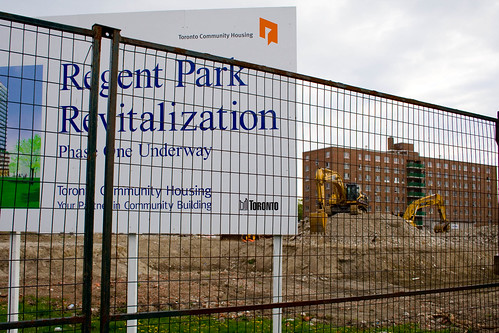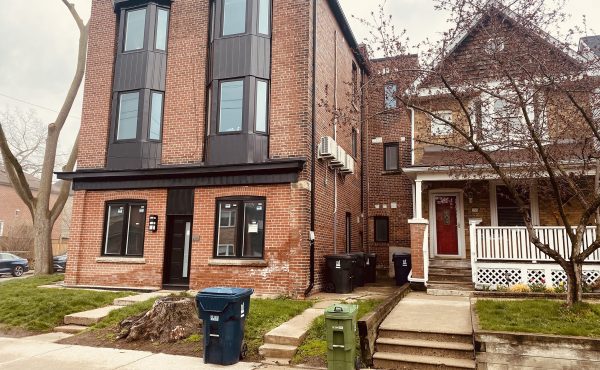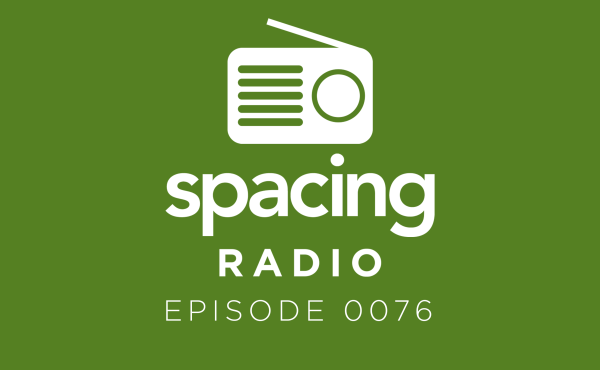 As the name suggests, every Friday Spacing profiles Facebook groups that are using the social network to articulate their experiences and share information about Toronto.
As the name suggests, every Friday Spacing profiles Facebook groups that are using the social network to articulate their experiences and share information about Toronto.
– – – – – – – – – – – – – – –
This week I searched for Toronto-based groups that are dealing with urban housing issues. While each group took a unique approach to the topic, three major themes seemed to emerge: development, revitalization, and advocacy.
Of major concern to many Torontonians seems to be how our city, as it continues to grow in size and density, is being developed to sustain increased numbers; but, new affordable housing is undermining existing communities, replacing much needed green space, and harming the environment. Stop the housing development @ Downview Park!!! is one such Facebook group. The government currently wants to replace one of the biggest urban parks in all of Canada with a housing complex. Advocates against the proposed development are arguing that the neighbourhood’s infrastructure could not support such a drastic density increase. Moreover, members of this group feel that the proposed high density buildings are not energy efficient and, unlike the existing park, they would worsen the environmental situation of the area.
That being said, other Toronto-based groups, such as Unite the Caring Cooperative Cohousing Project, are demonstrating the benefits of well-planned urban housing development in creating community. Members of this group, including local activists and planners, are proposing the development of an eco-village near the downtown core. Buildings would be retrofitted or designed to be energy efficient so as to reduce residence’s ecological footprint, consumption rates, and living expenses.
Local communities are also using Facebook to articulate how they feel about existing and proposed revitalization projects. Lawrence Heights (Jungle) “Revitalization†Project, for example, discusses how the physical revitalization of their neighbourhood would result in urban gentrification; a phenomenon whereby existing residents would be displaced by wealthier residents who can afford property as values increase. Revitalization Sucks!!!! is another one of these groups. Members are currently addressing the issue of development around Dufferin and Lawrence and how government sponsored surveys are strategically muting community protest.
There are also those groups that address housing more generally, as a moral and social issue. Stop Toronto Slums and Homos4Housing, for example, are in fact petition groups whereby people join as a way of showing that they want property values to go down.
All in all, these groups reflect a range of often conflicting viewpoints about Toronto’s housing issues. That being said, in doing so Facebook is offering urbanites a way of finding out about development and revitalization issues that they might not have known about otherwise; and, they have direct, unmediated access to community opinions.
photo by Geoffrey Wiseman




4 comments
I for one am highly in favour of the replacement of existing low income housing stock for a number of reasons. First off the majority of existing buildings have aged considerably and have reached a point where it is essentially cheaper to replace the buildings than refurbish them. For example I currently live in a TCHC property consisting of a single tower sixteen stories in height with 300 units, almost all bachelors with a few 1 bedrooms and all Rent Geared to Income. Interestingly my building was completed in 1970, which was just before the revolutionary City of Toronto non profit housing Corporation, Cityhome came into existence in 1976 (led by former mayor John Sewell). Its first newly completed property, the Hydro Block at Trinity Spadina consisted of a half block of expropriated older houses for large families on Beverley St. and on the other side of the block on Henry St, a very unique low rise linear building with built in townhomes and a windowed hallway on the thrid floor to let in natural light. Cityhome went on to construct other buildings such as its properties in the St. Lawrence neighborhood and elsewhere in the former city of Toronto. As with the Hydro Block all were low rise developments consisting of mixed income buildings which were meant to fit into the neighborhoods rather than overtake them. Sadly in 2001 when the new city of Toronto council created Toronto Community Housing, it was faced with acquiring a large number of older low income housing properties that were not only in disrepair, but were additionally designed under the outdated post WWII urban renewal mindset; resulting in their being socially unhealthy, as well as consisting mainly of higher built towers with an exclusivity of RGI units. But just as Toronto Community Housing acquired the older buildings formerly owned by Metro Housing and Ontario Housing, they also acquired the Cityhome properties. And through the lessons learned on how to and how not to build low income housing, TCHC was able to move forward with a plan to eventually make ALL of its properties in the megacity as socially healthy and progressive as those of the former Cityhome Corporation.
I don’t think that anyone ever suggested that Downsview Park be replaced with housing. In series of evolving concepts, housing was indeed proposed for the site, but I am not aware of a proposal to completely replace the park with housing. Let’s be careful with wording. We should also be careful to analyze facts and relationships. Can the park be meaningful ecologically without occupying the whole site? Can new residents be enticed to live more sustainably than surrounding residents, for example by not relying exclusively on cars? Would housing created on site displace housing that would otherwise go on greenfield sites?
In every “stable” residential community, one needs to carefully analyze residents’ environmental concerns. Often, residents are more interested in having only a park or houses just like theirs built than seeing city-wide issues addressed. And any proposal that will introduce a different demographic mix will often be poorly received anywhere.
As usual, there is usually more than meets the eye.
AB’s right — the Downsview Park group is perhaps a good example of why you should be careful when getting your news from Facebook!
The current proposal is to develop 362 acres as an urban national park, and turn the remaining 210 acres into a residential area. To really fight this effectively, you’d have to go back to the root cause: as set up by the federal government, the park is required to be self-financing. (I don’t think other national parks work that way.) Selling housing is how the park plans to pay for its own development.
Lets take for example my neighbours house in the Beach- 140 Waverley, abandoned by the City, needing tens of thousands of dollars in repair, they shut off the gas, leaving the windows wide open 2 winters ago. The pipes burst, washed out the foundation of not just that house but the 2 properties to the north!
Original estimates I hear are about 1.7 million dollars in damage, adjacent owner having to move and their houses due to unsafe conditions, and still the City does nothing….